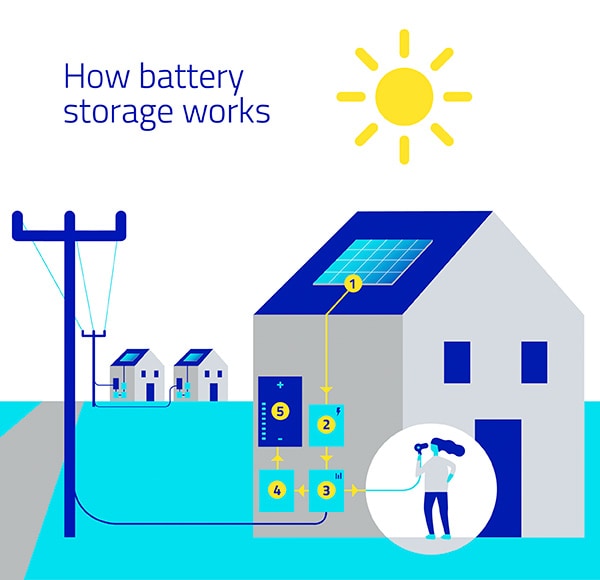The solar panels stop generating energy and the household switches to stored battery energy.
- The battery starts sending energy through the battery inverter to power the home.
- The battery inverter converts the energy into a form that appliances can use.
- The switchboard directs the energy to your appliances.
- When the battery’s charge runs out, the grid will kick in and provide energy to keep your appliances running.
Frequently asked questions
Is it worth having battery storage?
That depends on your circumstances, including your energy usage patterns, location and financial goals. If you already have a home solar system and you live in an area with frequent power outages, a solar battery storage system could be worth the investment.
If you’re a high energy household, or you tend to use more energy at night, you could also benefit more from battery storage due to the increased savings potential. Keep in mind the payback period can take a number of years.
And if sustainability is a high priority, solar batteries also help you reduce your carbon footprint even more by drawing less from the grid.
Another point to consider is the upfront cost of your battery – it will take some time for your extra bill savings to “pay back” your investment. However, thanks to the Federal Governments Cheaper Home Batteries Program, there’s never been a better time to buy a battery. The program now offers households a discount of around 30% off the upfront cost of a battery system (subject to some eligibility requirements). This discount will gradually decline each year, so consider getting in early.
You can get a personalised estimate of the upfront cost, payback period and bill savings for a battery with our Electrify Now tool.
Is a 10kWh battery enough to run a house?
A 10kWh solar battery can hold up to 10 kilowatt hours of power, but its usable capacity is slightly less - around 5-10% lower than actual capacity for lithium-ion based batteries. So if you think about a microwave, which typically uses 1 kW, a 10kWh battery can power it for up to 9 hours.
Whether a 10kWh battery is enough to run your house depends on the energy you consume and how you intend to use the solar battery. It might be enough if you’re planning to use it to power essential appliances like lights and fridges. Or if you simply want battery storage to reduce peak electricity charges or provide backup power during outages. But if you plan to use it to power continuous off-grid living, a higher storage battery may be better.
How long will a 10kWh battery last?
The run time of a 10kWh solar battery is influenced by energy usage. And the amount of energy you consume depends on the type appliances you use – and how long you use them for.
What is the lifespan of a solar battery?
Maintenance, monitoring, system quality, as well as environmental conditions, all play a role in the lifespan of your solar battery. Typically, a lithium-ion battery will last between 5-15 years.





